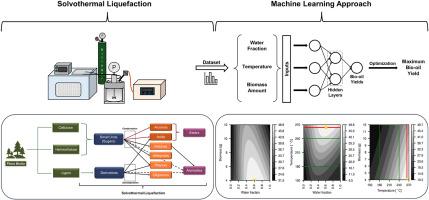Machine learning integrated solvothermal liquefaction of lignocellulosic biomass to maximize bio-oil yield
IF 6.2
2区 工程技术
Q2 ENERGY & FUELS
引用次数: 0
Abstract
Accelerating consumption of limited fossil-based for economic growth and simultaneously mitigating greenhouse gas emissions create a dilemma that is waiting to be solved by researchers. In this context, solvothermal liquefaction of lignocellulosic biomass to produce bio-oil is a promising way to obtain green energy. However, maximizing bio-oil is challenging to optimize the operating parameters employing conventional techniques due to the complexity and non-linearity of the process. Lately, machine learning approaches have become powerful tools for addressing complex nonlinear problems by predicting process behavior and regulating operating parameters for optimization by learning from datasets. The current research demonstrates integrating experimental and a developed artificial neural network model to optimize solvothermal liquefaction of pinus brutia, based on temperature, water fraction, and biomass amount in maximizing bio-oil generation for the first time. The highest bio-oil yields were obtained at 31.40 %, 18.68 %, and 39.69 %, respectively, with 4 and 8 g biomass in the presence of water, ethanol, and water/ethanol mixture at 240 °C. Under the model conditions, the maximum bio-oil yield was experimentally verified at 46.20 %, which was predicted at 48.8 %. Beyond providing accurate yield predictions, the approach highlights the potential of date-driven modeling to reduce experimental workload and cost while aiding parameter selection to improve efficiency. These outcomes emphasize the importance of machine learning integration into liquefaction process, providing remarkable results for future process design, optimization, and scalability. On the other hand, the study also includes characterization results (ultimate, proximate, FTIR, and GC–MS) of selected products and pinus brutia.

机器学习集成了木质纤维素生物质的溶剂热液化,以最大限度地提高生物油的产量
为了经济增长而加速消耗有限的化石燃料,同时减少温室气体排放,这是一个等待研究人员解决的难题。在这种情况下,木质纤维素生物质的溶剂热液化生产生物油是一种很有前途的获得绿色能源的方法。然而,由于过程的复杂性和非线性,利用传统技术优化操作参数是一项挑战。最近,机器学习方法已经成为解决复杂非线性问题的强大工具,通过从数据集中学习来预测过程行为和调节操作参数以进行优化。目前的研究首次将实验和开发的人工神经网络模型结合起来,基于温度、水分数和生物量来优化油松的溶剂热液化,以最大限度地提高生物油的产量。在水、乙醇和水/乙醇混合物存在的条件下,在240°C下,4 g和8 g生物质的生物油收率分别为31.40%、18.68%和39.69%。在模型条件下,实验验证了生物油的最大收率为46.20%,预测收率为48.8%。除了提供准确的产量预测外,该方法还强调了数据驱动建模的潜力,可以减少实验工作量和成本,同时帮助选择参数以提高效率。这些结果强调了将机器学习集成到液化过程中的重要性,为未来的过程设计、优化和可扩展性提供了显著的结果。另一方面,本研究还包括所选产品和粗松的表征结果(最终、近似、FTIR和GC-MS)。
本文章由计算机程序翻译,如有差异,请以英文原文为准。
求助全文
约1分钟内获得全文
求助全文
来源期刊

Journal of The Energy Institute
工程技术-能源与燃料
CiteScore
10.60
自引率
5.30%
发文量
166
审稿时长
16 days
期刊介绍:
The Journal of the Energy Institute provides peer reviewed coverage of original high quality research on energy, engineering and technology.The coverage is broad and the main areas of interest include:
Combustion engineering and associated technologies; process heating; power generation; engines and propulsion; emissions and environmental pollution control; clean coal technologies; carbon abatement technologies
Emissions and environmental pollution control; safety and hazards;
Clean coal technologies; carbon abatement technologies, including carbon capture and storage, CCS;
Petroleum engineering and fuel quality, including storage and transport
Alternative energy sources; biomass utilisation and biomass conversion technologies; energy from waste, incineration and recycling
Energy conversion, energy recovery and energy efficiency; space heating, fuel cells, heat pumps and cooling systems
Energy storage
The journal''s coverage reflects changes in energy technology that result from the transition to more efficient energy production and end use together with reduced carbon emission.
 求助内容:
求助内容: 应助结果提醒方式:
应助结果提醒方式:


